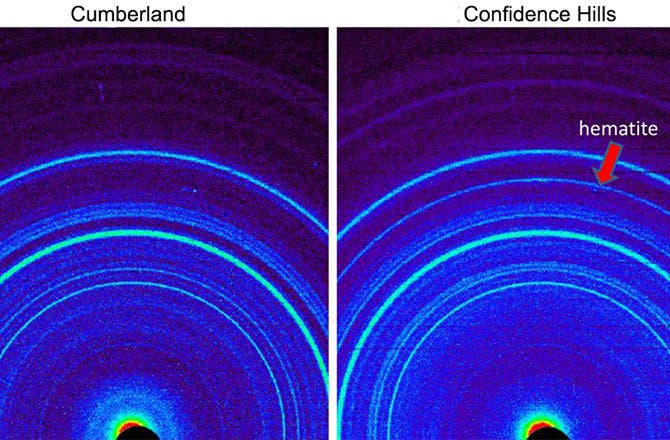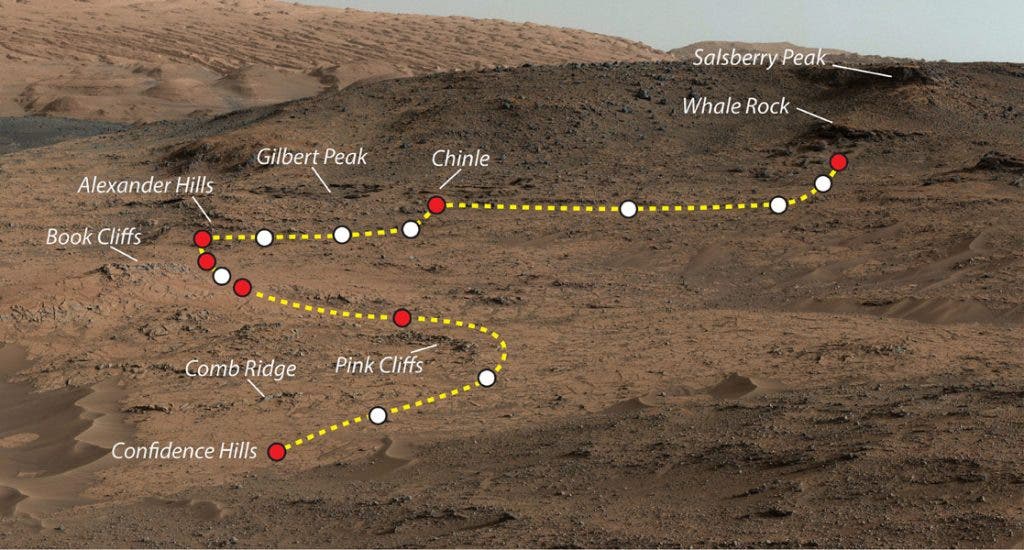For the first time in its mission to study Mars and the potential for life on it, the Curiosity Rover has identified a mineral. The rover took samples by drilling in a Martian mountain and was then able to make the identification. The mineral in case is called hematite.

Hematite is an iron oxide (Fe2O3) – one of several iron oxides actually. Colored black to steel or silver-gray, brown to reddish brown, or rarely red, hematite is usually associated with water, but it can occur without water as well. The spectral signature of hematite was seen on the planet Mars by the infrared spectrometer on the NASA Mars Global Surveyor (“MGS”) and 2001 Mars Odyssey spacecraft in orbit around Mars. However, this is the first time the mineral has been identified in situ.
Curiosity Project Scientist John Grotzinger, of the California Institute of Technology in Pasadena, said in a statement:
“This connects us with the mineral identifications from orbit, which can now help guide our investigations as we climb the slope and test hypotheses derived from the orbital mapping.”
Naturally, this find is interesting for several reasons. First of all, since the mineral typically occurs in aqueous environments and its existence on Mars was confirmed, it could be an indication of former (or perhaps even present) Mars habitation.
“We’ve reached the part of the crater where we have the mineralogical information that was important in selection of Gale Crater as the landing site,” said Ralph Milliken of Brown University, Providence, Rhode Island, and member of Curiosity’s science team. “We’re now on a path where the orbital data can help us predict what minerals we’ll find and make good choices about where to drill. Analyses like these will help us place rover-scale observations into the broader geologic history of Gale that we see from orbital data.”
Hematite is a good environmental indicator – in other words, there’s a good chance that studies on the mineral can reveal how the surface of the Red Planet looked like in the geological past. Also, the fact that Curiosity was able to identify the mineral is also a good sign; it shows that the machines are working fine and we can expect more intriguing discoveries in the future. For example, this tiny sample alone contains magnetite, hematite and olivine in a range of oxidization states.
Magnetite is another iron oxide (Fe3O4) most known for being naturally magnetic. The fact that it was found in conjunction with hematite suggests that the hematite was formed by magnetite degradation. This happens when magnetite is exposed to water and the atmosphere, so again, a good suggestion. Olivine is a mineral which occurs in igneous rocks.

This sample was taken from a location dubbed “Confidence Hills” at the base of Mount Sharp (a.k.a. Aeolis Mons) at an outcrop called “Pahrump Hills.” The mountain appears to be an enormous mound of eroded sedimentary layers sitting on the central peak of Gale. It rises 5.5 km (18,000 ft) above the northern crater floor and 4.5 km (15,000 ft) above the southern crater floor. The drilled rock dust was then dropped into CheMin, which uses X-ray diffraction to detect the chemical fingerprint of minerals locked in the rock. X-ray diffraction is a tool used for identifying the atomic and molecular structure of a crystal by emitting a beam of light and then measuring how the diffracted beams bounce off of the crystal.

Another NASA Mars rover, Opportunity, made a key discovery of hematite-rich spherules on a different part of Mars in 2004. That finding was important as evidence of a water-soaked history that produced those mineral concretions.
The discovery further strengthens that at one point in its past, Mars was much wetter than it is now. It also shows how important it is to conduct more studies on the surface of Mars. We need to get more instruments there, more rovers, or why not – more boots.






